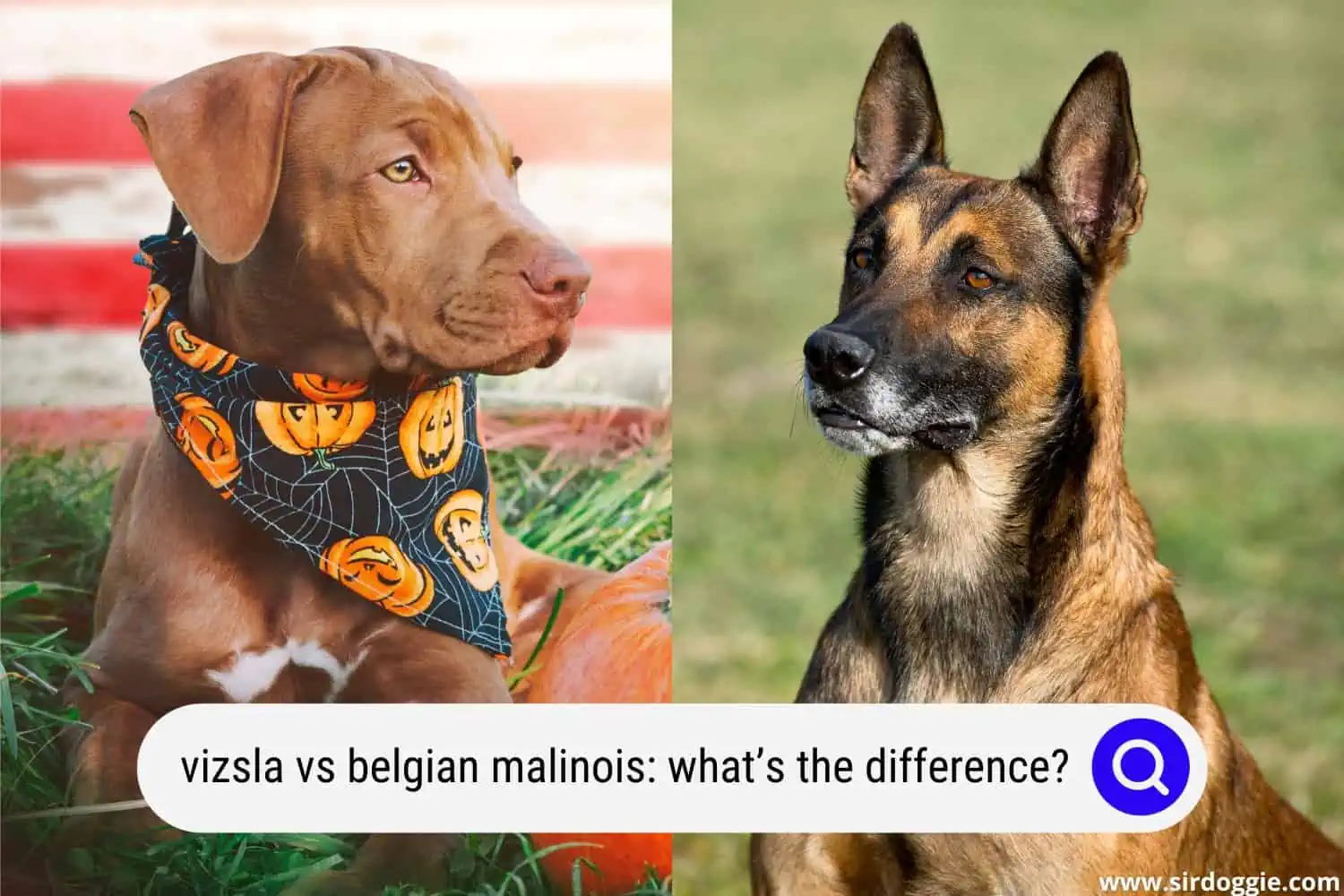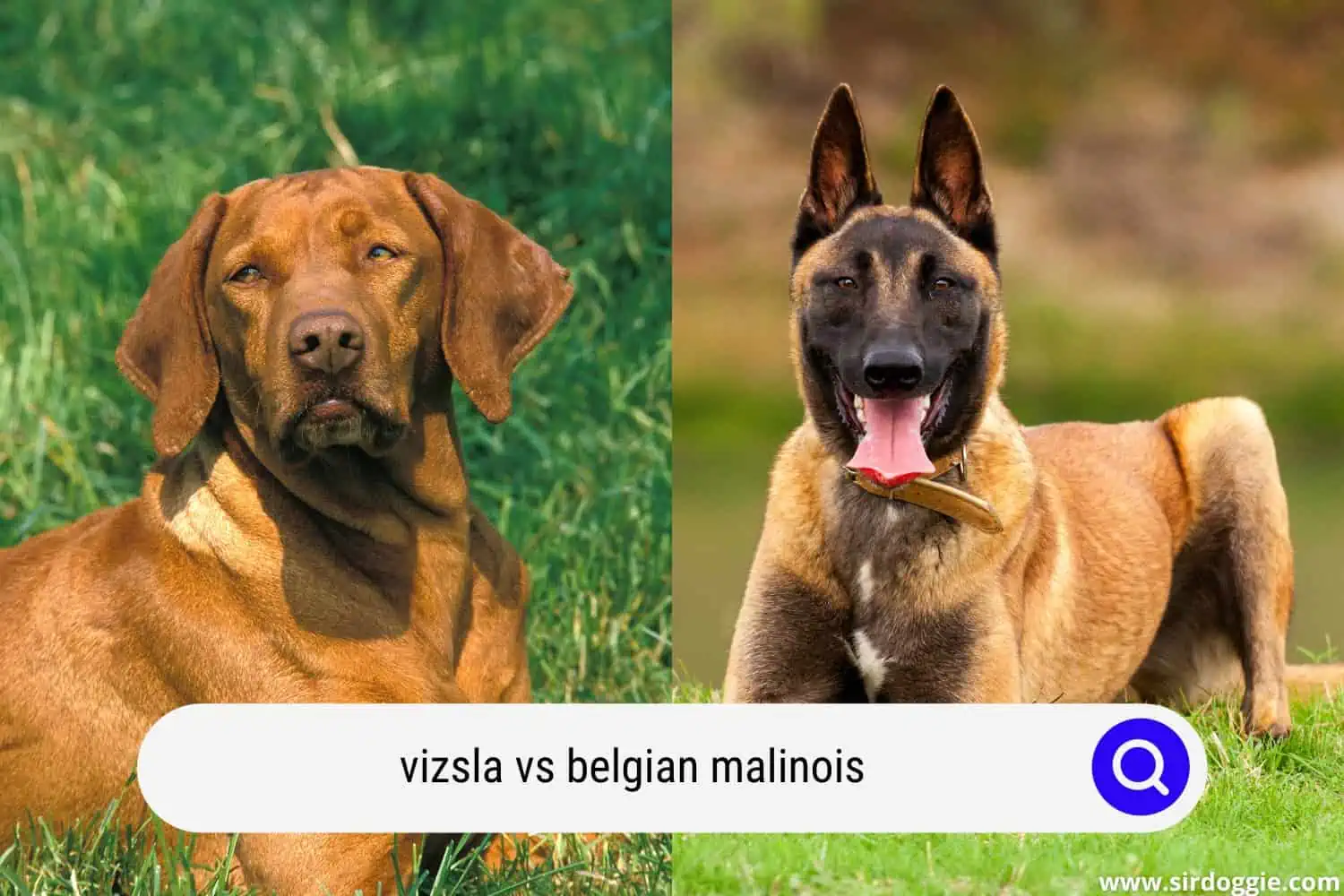Vizsla vs Belgian Malinois: What’s the Difference?
In physical appearance, both the Vizsla and the Belgian Malinois look almost the same: almost the same height and weight. They are both medium dogs with short and dense coats but with low grooming maintenance. So, how does the Vizsla compare with the Belgian Malinois?
In this Vizsla vs Belgian Malinois comparison article, we will see the characteristics, character, health challenges, and care requirements of each dog and help you find out which would be the best for you: the Vizsla or the Belgian Malinois.

The Vizsla: a hunting and companion dog
The Hungarian Pointer or Vizsla is the smallest of the pointers. Lean and muscular, this versatile dog is excellent both in the hunting field and as a loyal family dog.
Origin of the Vizsla, a breed that almost went into extinction
The Hungarian pointer or vizsla originates from Hungary. This ancient breed began in the Middle Ages at the hands of nomadic tribes, who used it for its hunting qualities.
In the fourteenth century, the first written reference to the ancestors of these dogs appeared, but it was in the eighteenth century that they were renowned as hunting dogs. The Hungarian pointer was a highly prized dog and was considered a symbol of the noble class and aristocracy.
At this time, the breed still did not have the modern appearance that we know today since its function as a working dog was prioritized and not so much its beauty.
In the nineteenth century, the breed almost went into extinction due to various wars and occupations. But people managed to gather the last specimens, a dozen dogs to save the vizsla from disappearance. Blood from other European hunting dogs such as the English pointer and the German pointer was introduced into their lineage.
The active and sociable character of the Vizsla
The Hungarian Pointer has a balanced, active, lively, and sociable character. It is an intelligent dog that is easy to train as it is always attentive and willing to please its owner.
The dog must be educated positively and calmly, as its sensitive nature causes it to respond poorly to yelling, causing it to become aggressive, distrustful, or excessively shy.
It is a dog that loves to be in company and does everything for its owner. On the field, the Vizsla is a hard worker who is always tireless and motivated. Always ready, attentive, and willing; these are some of the traits that define its personality.
As a family dog, it is calm, affectionate, playful, and very patient with children. It is a clever and versatile dog that adapts perfectly to family life. It makes an excellent companion animal.
Due to its athletic build and high energy level, this dog needs regular physical activity and is therefore not suitable for everyone. Anyone who wants to share their life with a vizsla should have time to walk it daily and allow it to run freely. It is an ideal dog for people who live in the countryside, in rural areas, or who have a large garden at home.
The vizsla is a versatile hunting dog, which has traditionally served as both a pointer and a retriever in hunting pheasants and rabbits.
It is an agile, clever, fast, resistant animal that is suitable for many terrains. They can hunt both in the forest and in mountainous or stony areas thanks to their athletic physique. They also perform well in the water.
Among its qualities are its great sense of smell, its ability to vent, and its diligence in bringing back the hunted pieces. It is also a brave dog that is not easily scared of noise or wild animals.
Characteristics of Vizsla, the smallest pointer dog in the world
The Hungarian Vizsla is a slender hunting dog. Its body is light, lean, wiry, and muscular. Its hair is short, smooth, and shiny, with a yellowish seed color.
Medium in size, their weight is 22 to 30kg for the male and 18 to 25kg for the female. Its height is 58 to 64 cm for the male and 54 to 60 cm for the female.
The Vizsla is the smallest pointer in the world. Height and wingspan are where the breed has a shortfall.
Its athletic, slim, and muscular body describes its very beautiful and elegant shapes. Its movement is agile, and fluid, in a powerful trot that covers the ground well. While moving, its back remains straight horizontally, well upright, and without slackening.
The loin is firm, straight, strong, and muscular. The tail is set rather low, wider at the base, tapering towards the tip. When the dog is inactive, the tail falls to the hock, and when in motion, it rises to the horizontal.
Its skull is softly domed and wide without excesses. The muzzle is straight and ends blunt, not pointed. The pointer has long and powerful jaws. It has a broad nose, with wide-open nostrils. The color of the nose is the same as the coat, in a slightly darker tone.
It has broad, thin ears and a rounded V-tip. They fall on the sides of the face, on the cheeks. The eyes of the vizsla are of medium size, smooth and oval. They are brown, consistent with the coat. Its gaze has an intelligent, attentive, and lively expression.
Health of the Vizsla
The Hungarian Vizsla is a healthy dog in general terms, but some dogs can be affected by some ailments, depending on the breeder. The most common diseases of the Hungarian pointer are:
- Epilepsy
- Diseases that affect blood clotting, such as hemophilia.
- Hip dysplasia
- Hormonal problems like hypothyroidism
- Cancer such as lymphosarcoma
- The neuropathies are also possible, but these are manifested in much less frequent numbers.
The Hungarian Pointer can live from 10 to 14 years. They are considered to be a generally healthy breed, with few health problems.
The Belgian Malinois: a sporty, cunning, and hardworking dog
We like the intelligence and liveliness of the Malinois. But that is not all! It is a sporty and cunning dog that always looks for tasks. Due to its innumerable capacities, the dog is today in great demand from the police. It is also suitable for companionship in family homes provided you give it physical activities regularly.
History and origin of the Belgian Malinois
The Malinois originates from Belgium. These sheepdogs have existed for close to a century in Belgium. They nevertheless have sported various physical looks.
At the beginning of the 20th century, breeders led by the renowned veterinarian Adolphe Reul, however, decided to change the dog’s morphology. This resulted in the birth of the Belgian shepherds, which are now of four types.
Characteristics of the Malinois
The Malinois belongs to the great family of Belgian Shepherds in the same way as the Tervueren (short coat of charcoal and fawn color), the Laekenois (hard coat of charcoal and fawn color), and the Groenendael (long and black hair).
It is distinguished by its short hairs and its nuanced tawny coat of charcoal gray to brown color. With a harmonious physique and a slender silhouette, the Malinois sports a straight head on which stands two rather small and triangular ears.
The medium-sized eyes have an almond shape and are dark in color. The muzzle is long and the stop is a little bit accentuated. The breed wears a black mask on the face.
Personality of the Malinois, a breed that loves water
Overflowing with vitality, very vigilant, and always on the alert, the Malinois possesses many qualities that have earned it the recognition of the police who call on it for all kinds of tasks.
This dog is always ready to go into action and is very protective of its owners. Moreover, it is better to educate it and socialize it from an early age to prevent it from attacking all the people who get too close to you.
The Malinois has all the skills necessary to be an excellent defense, shepherd, guard, or service dog. It is neither aggressive nor fearful and can work well with children. On the other hand, it will be necessary to provide a large house with a garden to accommodate it. You must also take it out on regular walking sessions.
Comparison Table: Vizsla vs Belgian Malinois
| Belgian Malinois | Vizsla | |
| Size | Medium size Weight: male 29 – 34 kg, female 25 – 34 kg Height: male 61 – 66 cm, female 56 – 61 cm | Medium size Weight: male 22-30kg, female 18-25kg. Height at the withers: male 58-64 cm., female 54-60 cm |
| Color | solid golden-rust color | Seed yellow |
| Origin | Belgium | Hungary |
| Skills | Searching and rescuing; watch and guard dog, | hunting and companion dog |
| Other Names | Berger Belge Malinois, Mali, Mechelse Berger | Hungarian Pointer, Magyar Vizsla |
| Life span | 12 to 14 | 10 to 14 |

Conclusion
While the Vizsla originates from Hungary, the Belgian Malinois originates from Belgium. Both dogs have almost the same height and weight. They both require little maintenance. However, the Belgian Malinois lives a bit longer than the Hungarian pointer and has fewer health challenges than the Vizsla.
The Vizslas are good, strong hunting and companion dogs. Meanwhile, the Belgian Malinois is good for search and rescue. They are ideal herding dogs that can watch and guard.

Family Dog Expert Author
Hi there! I’m Stuart, a devoted dog lover and family dog expert with over a decade of experience working with our furry companions. My passion for dogs drives me to share my knowledge and expertise, helping families build strong, loving bonds with their four-legged friends. When I’m not writing for SirDoggie, you’ll find me hiking, playing with my beautiful dog, or studying music.